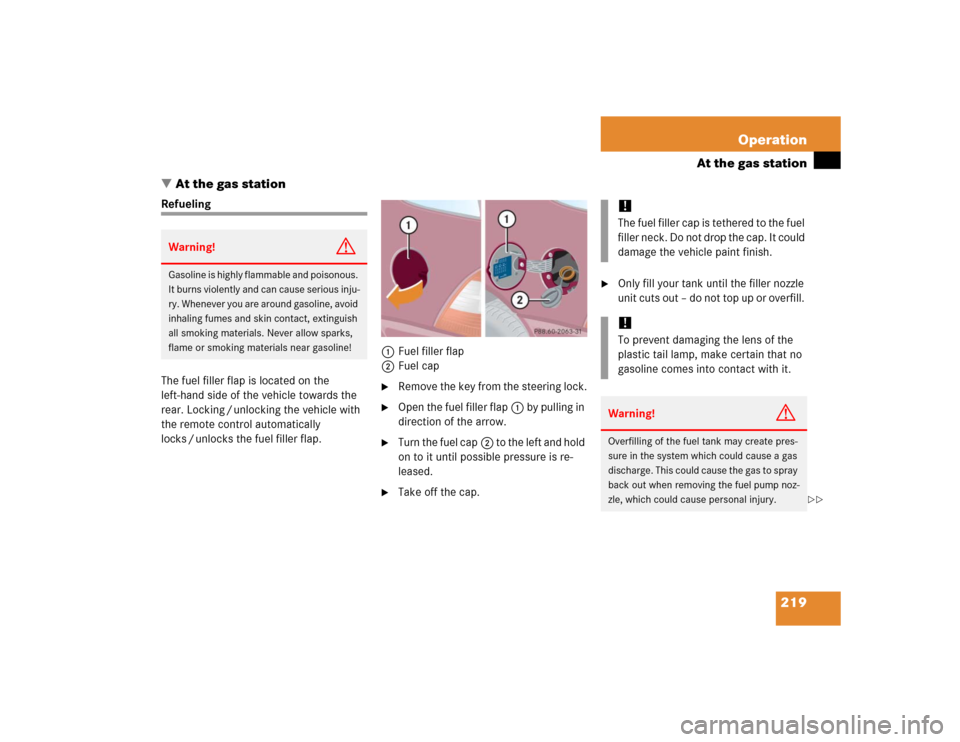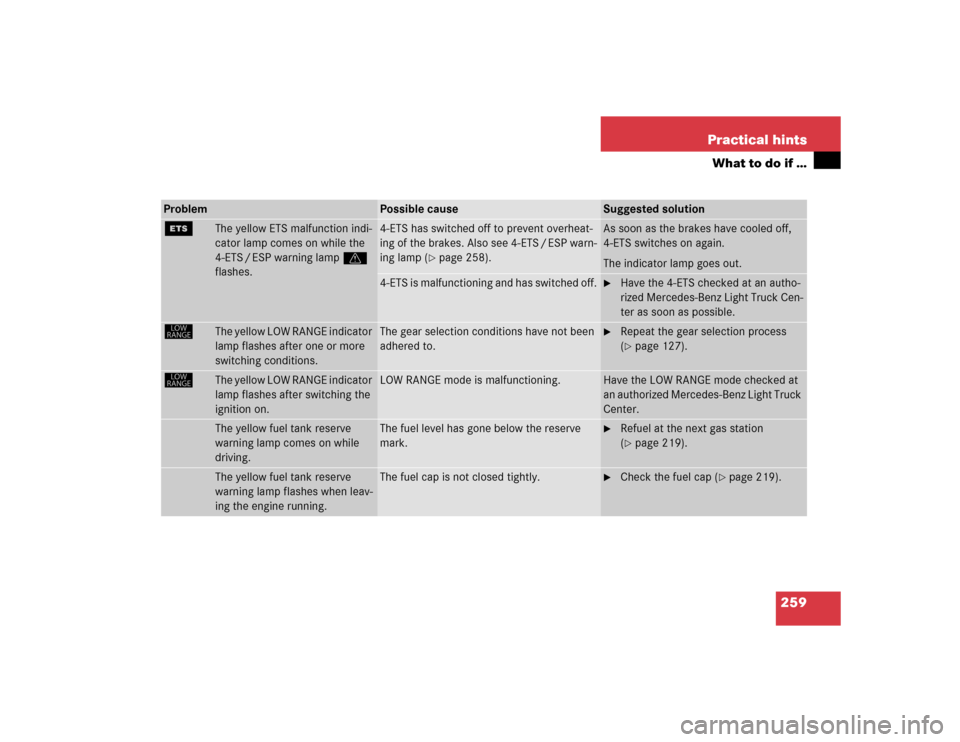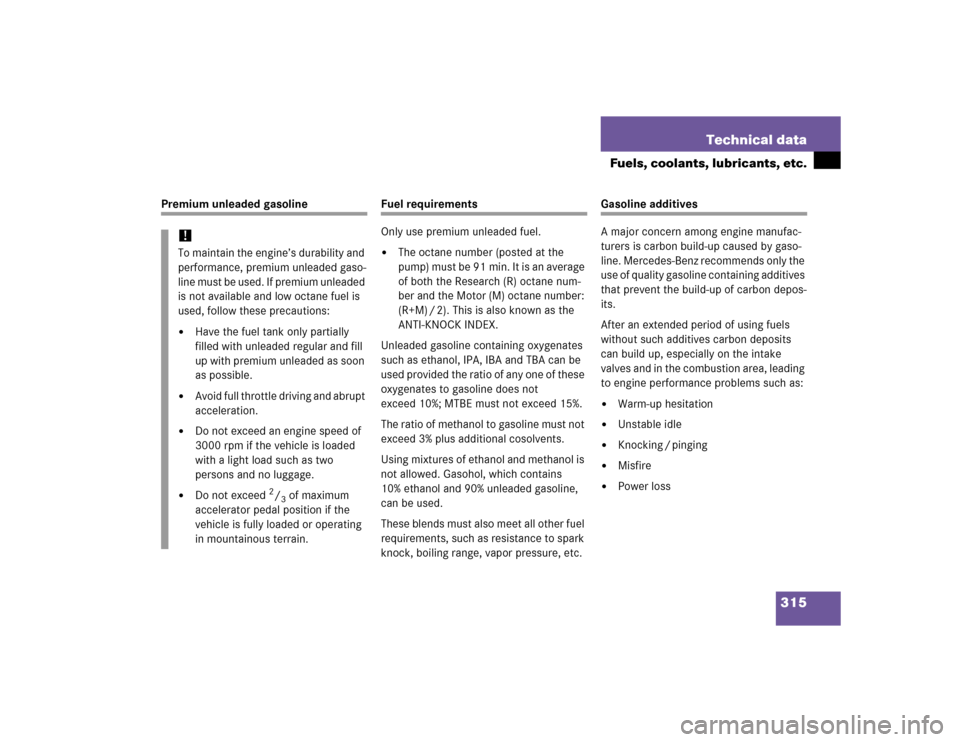Page 221 of 356

219 Operation
At the gas station
�At the gas station
Refueling
The fuel filler flap is located on the
left-hand side of the vehicle towards the
rear. Locking / unlocking the vehicle with
the remote control automatically
locks / unlocks the fuel filler flap.1Fuel filler flap
2Fuel cap
�
Remove the key from the steering lock.
�
Open the fuel filler flap1 by pulling in
direction of the arrow.
�
Turn the fuel cap2 to the left and hold
on to it until possible pressure is re-
leased.
�
Take off the cap.
�
Only fill your tank until the filler nozzle
unit cuts out – do not top up or overfill.
Warning!
G
Gasoline is highly flammable and poisonous.
It burns violently and can cause serious inju-
ry. Whenever you are around gasoline, avoid
inhaling fumes and skin contact, extinguish
all smoking materials. Never allow sparks,
flame or smoking materials near gasoline!
!The fuel filler cap is tethered to the fuel
filler neck. Do not drop the cap. It could
damage the vehicle paint finish.!To prevent damaging the lens of the
plastic tail lamp, make certain that no
gasoline comes into contact with it.Warning!
G
Overfilling of the fuel tank may create pres-
sure in the system which could cause a gas
discharge. This could cause the gas to spray
back out when removing the fuel pump noz-
zle, which could cause personal injury.
��
Page 222 of 356
220 OperationAt the gas station�
Replace the fuel cap by turning it to the
right.
You will hear when the fuel cap is tight-
ened.
�
Close the fuel filler flap.iOnly use premium unleaded gasoline
with a minimum Posted Octane Rating
of 91 (average of 96 RON / 86 MON).
Information on gasoline quality can
normally be found on the fuel pump.
For more information on gasoline, see
the Factory Approved Service Products
pamphlet.
iLeaving the engine running and the fuel
cap open can cause the yellow fuel
tank reserve warning lamp to flash and
the? malfunction indicator lamp
(USA only) or the± malfunction in-
dicator lamp (Canada only) to illumi-
nate.
For more information, see “Practical
hints” (
�page 254).
��
Page 261 of 356

259 Practical hints
What to do if …
Problem
Possible cause
Suggested solution
{
The yellow ETS malfunction indi-
cator lamp comes on while the
4-ETS / ESP warning lampv
flashes.
4-ETS has switched off to prevent overheat-
ing of the brakes. Also see 4-ETS / ESP warn-
ing lamp (
�page 258).
As soon as the brakes have cooled off,
4-ETS switches on again.
The indicator lamp goes out.
4-ETS is malfunctioning and has switched off.
�
Have the 4-ETS checked at an autho-
rized Mercedes-Benz Light Truck Cen-
ter as soon as possible.
ê
The yellow LOW RANGE indicator
lamp flashes after one or more
switching conditions.
The gear selection conditions have not been
adhered to.
�
Repeat the gear selection process
(�page 127).
ê
The yellow LOW RANGE indicator
lamp flashes after switching the
ignition on.
LOW RANGE mode is malfunctioning.
Have the LOW RANGE mode checked at
an authorized Mercedes-Benz Light Truck
Center.
The yellow fuel tank reserve
warning lamp comes on while
driving.
The fuel level has gone below the reserve
mark.
�
Refuel at the next gas station
(�page 219).
The yellow fuel tank reserve
warning lamp flashes when leav-
ing the engine running.
The fuel cap is not closed tightly.
�
Check the fuel cap (
�page 219).
Page 315 of 356
313 Technical data
Fuels, coolants, lubricants, etc.
Model
Capacity
Fuels, coolants, lubricants, etc.
Cooling system
approx. 12.7 US qt (12.0 l)
MB Anticorrosion / Antifreeze
Fuel Tank
including a reserve of
ML 350, ML 500
22.0 US gal (83.0 l)
approx. 3.2 US gal (12.0 l)
Premium unleaded gasoline:
Minimum Posted Octane 91
(Avg.of96RON/86MON)
Air conditioning system
R-134a refrigerant and special PAG lubricant oil
(never R-12)
Windshield washer and
headlamp cleaning
system*
8.0 US qt (7.6 l)
MB Windshield Washer Concentrate
1
1Use MB Windshield Washer Concentrate “S” and water for temperatures above freezing or MB Windshield Washer Concentrate “S” and commercially available
premixed windshield washer solvent / antifreeze for temperatures below freezing. Follow suggested mixing ratios (�page 319).
Page 317 of 356

315 Technical data
Fuels, coolants, lubricants, etc.
Premium unleaded gasoline
Fuel requirements
Only use premium unleaded fuel.�
The octane number (posted at the
p um p) m us t be 91 mi n. It i s an a vera ge
of both the Research (R) octane num-
ber and the Motor (M) octane number:
(R+M) / 2). This is also known as the
ANTI-KNOCK INDEX.
Unleaded gasoline containing oxygenates
such as ethanol, IPA, IBA and TBA can be
used provided the ratio of any one of these
oxygenates to gasoline does not
exceed 10%; MTBE must not exceed 15%.
The ratio of methanol to gasoline must not
exceed 3% plus additional cosolvents.
Using mixtures of ethanol and methanol is
not allowed. Gasohol, which contains
10% ethanol and 90% unleaded gasoline,
can be used.
These blends must also meet all other fuel
requirements, such as resistance to spark
knock, boiling range, vapor pressure, etc.
Gasoline additives
A major concern among engine manufac-
turers is carbon build-up caused by gaso-
line. Mercedes-Benz recommends only the
use of quality gasoline containing additives
that prevent the build-up of carbon depos-
its.
After an extended period of using fuels
without such additives carbon deposits
can build up, especially on the intake
valves and in the combustion area, leading
to engine performance problems such as:�
Warm-up hesitation
�
Unstable idle
�
Knocking / pinging
�
Misfire
�
Power loss
!To maintain the engine’s durability and
performance, premium unleaded gaso-
line must be used. If premium unleaded
is not available and low octane fuel is
used, follow these precautions:�
Have the fuel tank only partially
filled with unleaded regular and fill
up with premium unleaded as soon
as possible.
�
Avoid full throttle driving and abrupt
acceleration.
�
Do not exceed an engine speed of
3000 rpm if the vehicle is loaded
with a light load such as two
persons and no luggage.
�
Do not exceed
2/3 of maximum
accelerator pedal position if the
vehicle is fully loaded or operating
in mountainous terrain.
Page 339 of 356

337 Index
Fuel additives 315
Fuel filler flap 219
Locking 219
Opening 269
Unlocking 219
Fuel requirements 315
Fuel tank
Filler flap 219
Fuels, coolants, lubricants etc. 312
Functions
Trip computer* 189
Fuse box 299
Fuse chart 298
Fuse extractor 298
Fuses 297
Fuse box in passenger footwell 299
Fuse chart 298
Fuse extractor 298
Main fuse box 298
Spare fuses 298G
Garage door opener 29, 183
Erasing in remote control 188
Gasoline additives 315
Gasoline see Fuel
Gauge for
Coolant temperature 25
Fuel 25
Outside temperature 25
GAWR (Gross Axle Weight Rating) 324
Gear range 324
Automatic transmission 122
Limiting 122
Shifting into optimal 121
Gear range limit
Canceling 121
Gear selector lever
Cleaning 244
Position 123
Glass breakage sensor 84
Global Positioning System (GPS) 325Glove box 23, 167
Closing 167
Opening 167
Good visibility 128
GPS 325
GVW (Gross Vehicle Weight) 324
GVWR (Gross Vehicle Weight
Rating) 324
H
Hard plastic trim items
Cleaning 244
Hazard warning flasher 113
Switching off 113
Switching on 113
Head restraints
Manual seats 37
Power seats* 39
Headlamp aim
Adjusting 282